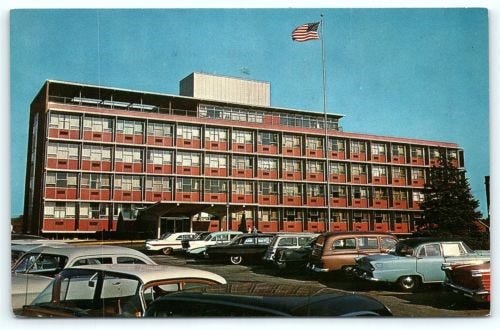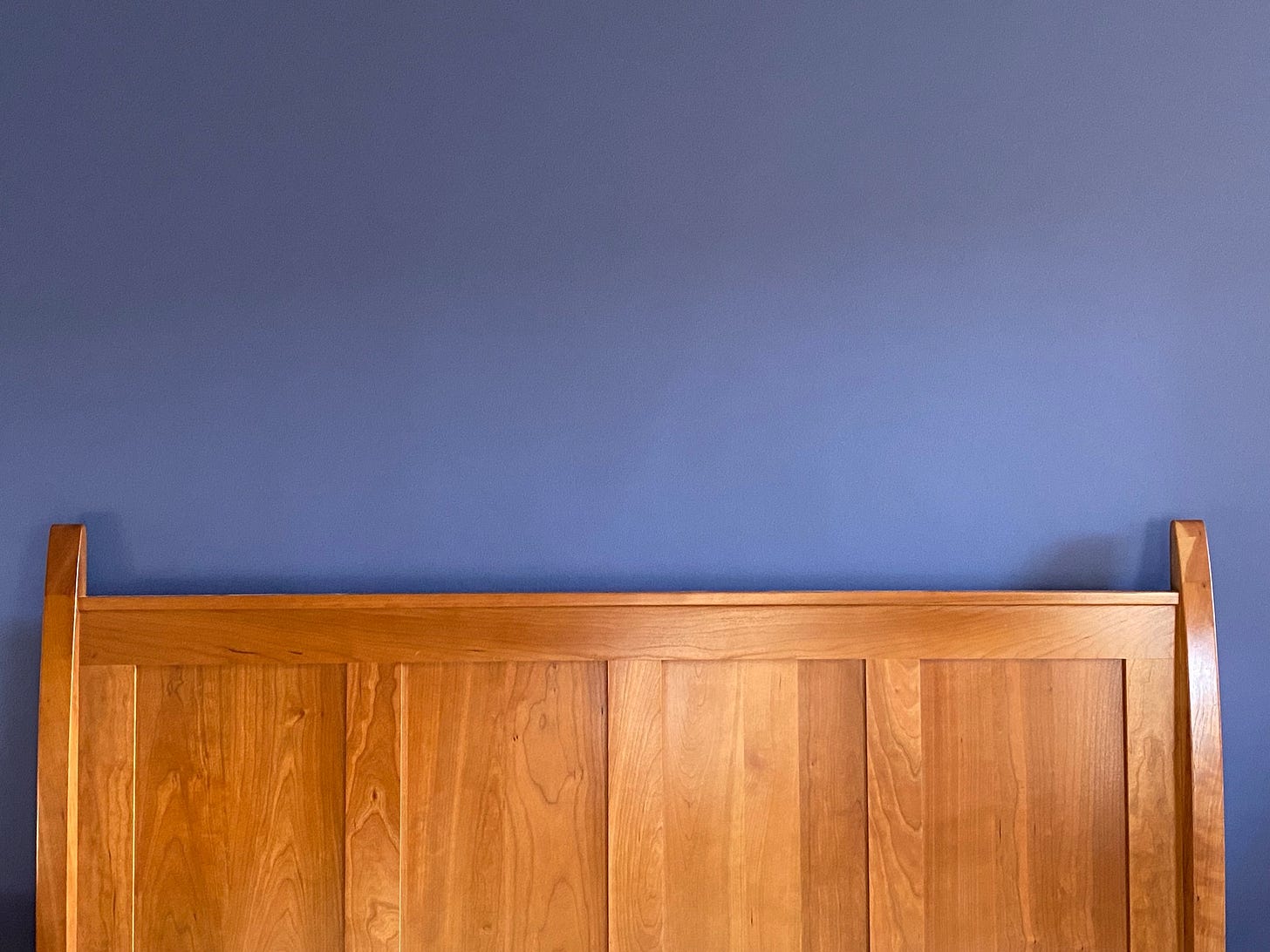For thirteen winters, I snuggled under, took refuge in, and logged hours of deep sleep cocooned within a beloved comforter. I bought it at the beginning of a separation from a long marriage. It was navy blue with a pale gray border and embroidered patterns swirling all over it–white stitching on the blue part, blue stitching on the gray part. Its external side had a smooth, silky feel to it, while the underside was soft. It came with two pillow shams and a bedskirt and had some heft to it, unlike any other comforter I’d ever had. There was something solid and regal about it.
They say you can never go home again,1 but it seemed inevitable at the time, back in 2011, and that’s what I did, renting a Victorian duplex in Pottstown, Pennsylvania, across the street from the building where I’d been born, when it had been a new hospital. There’s almost always a postcard from that era for sale on eBay with a Plymouth Belvedere, Ford Galaxie, and Studebaker Lark Wagon in the parking lot, and an American flag fluttering in the breeze at the top of a very tall flagpole. The sky is cloudless and brilliantly blue, like so many skies from my childhood.
My place was an early 20th century brick twin with front and side porches. The two houses I had shared with my husband had been modern ones, but I’d always pined after 100-year-old hardwood floors, trim, and doors—some fantasy about living in a simpler time, perhaps, whatever the hell that meant. By the time I moved back in 2011, the hospital had become a facility providing short-term rehabilitation services and long-term residential care. The patients often sat outside near the front entrance, or off to the side under a tree, with friends and relatives who’d come to visit, the now-classic cars replaced by Ford Fiestas, Dodge Grand Caravans, and Chevy Cavaliers.
That first night I curled up on a couple of chaise lounge cushions, crammed together under a Bugs Bunny fitted twin sheet, my makeshift bed on the floor in the front bedroom on the second story. The windows were wide open and a fan from Sears hummed at my feet. The cloying smell of polyurethane from newly-sealed hardwood floors swirled around, and my mind raced. Every once in a while, a car whizzed by, breaking through the whir of the fan. Charlotte Street was a heavily-traveled, two-lane, state road that cut north-south through the center of the Borough. Eventually, I slept.
Around 2 a.m., a man’s voice, spewing epithets, jolted me awake, followed by a woman’s voice, taunting him. I rolled onto my hands and knees and crept to one of the windows. They were on the opposite sidewalk, under the incandescent glow of a street light, like actors on a stage in a darkened theater. They were moving away, toward the downtown, never breaking stride. He was in her face. I was ready to call 911. And then he disengaged, striding out in front of her, leaving her behind, but turning back every few steps to remind her that he was done, through with her, it was really over this time. The argument continued as they moved onto the next block, then out of sight and out of earshot.
A few hours later, I woke again with a start. Voices carried through the window as though they were right there on the roof of my front porch, talking quietly. Again, I crept to the window. I could just make out three people at the bus stop across the street in their scrubs, taking a smoke break from the rehab facility. I fell back asleep until about 4:30 a.m., when the shearing of metal-on-metal set my heart into a jittery cadence.
Ohmygod this is it someone’s breaking in my front door forcing the vintage door knob there was only one deadbolt I knew it wouldn’t be enough how could this be happening on my first night on my own in my entire life I am 48 years old and someone is breaking in maybe Dad is right I need a gun.
I fought through the haze and snapped to full attention. A motor was running. Now there was the slam of metal-on-metal. In an instant I was back at the window. Across the street, someone moved from the sidewalk to get back behind the wheel of a van and drive away. It had only been a newspaper delivery person, filling the newspaper boxes near the bus stop.
I fell back into the embrace of Bugs Bunny, Daffy Duck, and the Tasmanian Devil. I needed to get a grip. No one was out to get me. And if I could hear all these people so clearly, then if anything were happening to me and I screamed for help, at least a dozen people would likely hear me.
Please understand: this vigilance was not the result of my marriage, but of writing a book about my childhood–my relationship with my father, his shooting of a neighbor, and the impact of the various authoritarian and misogynistic systems that ruled my life then. I was conscious/unconscious during the many years of research, conversations, re-traumatizing, and processing it took to write the many drafts of that manuscript. In 2011, I was drawn inexorably back to Pottstown to put myself in the midst of the people, places, and circumstances that had created this fearful, hypervigilant part of myself. Here she was, showing up in full force on my first night in that rented house.
Maybe living in a “simpler time” is a euphemism for being unawake or in denial about your own suffering and the suffering all around you.
Within the next hour, auto and truck traffic began to pick up. Apparently, this was how Pottstown woke up on this little stretch of Charlotte Street, the place that would be home for the next two years.
But after a week or so, I thought, “What am I doing? Why am I living like this? I can afford a mattress and a frame, sheets and a comforter. I deserve a comforter.”
Whenever I had bought home furnishings before, I had leaned toward the masculine, partly in deference to my husband and what I thought he would like, but also because I’d never been a frou-frou person. But at that time of opening myself to who I was, or who I could be, I didn’t want a comforter in my previous default palette: something with geometric patterns or in tans and grays.
I think I got this blue/gray set on sale at Bed Bath & Beyond, handing over as many of the coupons as they would accept, back when that was a thing. (I’ve never paid full price for a comforter set!) This bedding lasted me through two winters in that house on Charlotte Street, two winters in faculty housing at the Hill School, six winters in the house in Maine, two winters in an apartment in Princeton, and one final winter in my new-old home. The vast majority of those hours were spent alone.
Nearly a year ago, shortly after the move to my own Victorian, I had some dated wallpaper taken down in the primary bedroom and had Benjamin Moore’s 2024 Color of the Year–Blue Nova 825–painted on three of the walls. If serenity were a color, for me it would be Blue Nova.
When I went to paint the walls, I wasn’t thinking about the embroidered blue/gray comforter. It had always provided a warm cocoon in rooms with some version of off-white walls. Now, it was too much blue with the Blue Nova. My summer-weight comforter (white with a lighter blue pattern) contrasts well with the walls, and I already have a couple of thinner cotton blankets that will layer well and provide that snug feeling we all want when the warmth of summer departs. Besides, closet space is at a premium now—there is no room for two comforters.
So it’s time to pass on this blanket that has served me so well, is in great shape, and still feels substantial, even a bit royal. I am sending it along to a nearby dropbox, with gratitude for its comforting embrace all these years.
Apparently, it was journalist and activist Ella Winter who said to Thomas Wolfe, “Don’t you know you can never go home again?” And he asked her for permission to use the phrase for the title of his novel, You Can’t Go Home Again, published posthumously in 1940.







